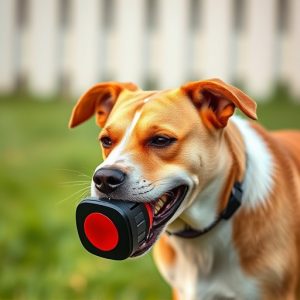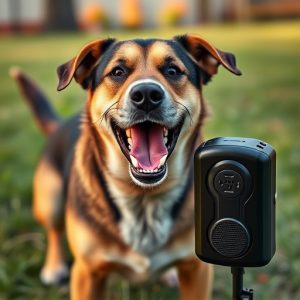Personal Protection Against Aggressive Dogs: Adjusting Sonic Repellent Training Levels
Understanding a dog's behavior, especially aggression triggers like fear or past trauma, is key…….
Understanding a dog's behavior, especially aggression triggers like fear or past trauma, is key for personal safety. Recognizing body language signals is crucial. Early intervention and adjusting training levels, including sonic repellent intensity, are vital to prevent unwanted behaviors. Sonic repellent devices, effective yet safe, rely on tailored training levels. A comprehensive personal protection strategy combines skill training with environmental design, incorporating secure fencing, lighting, and reflective surfaces. Regular updates based on training and local conditions ensure optimal safety.
Personal protection from aggressive dogs is a critical concern for many. This comprehensive guide explores effective strategies to safeguard yourself in the face of potential dog aggression. We delve into understanding canine behavior, recognizing triggers, and the unique role of sonic repelents in adjusting training levels for optimal protection. Additionally, we offer practical tips beyond training to create a safer environment, ensuring your peace of mind and security.
- Understanding Aggressive Dog Behavior: Recognizing Triggers and Signals
- The Role of Sonic Repellents: Adjusting Training Levels for Effective Protection
- Practical Strategies for Personal Safety: Beyond Training, Creating a Safe Environment
Understanding Aggressive Dog Behavior: Recognizing Triggers and Signals
Understanding a dog’s behavior is crucial when it comes to personal protection. Aggressive behavior can often be triggered by various factors, and recognizing these signals is essential for your safety. Dogs may exhibit aggression due to fear, territorial instincts, or past traumatic experiences. By paying close attention to their body language, you can identify when they are about to display aggressive tendencies. Tail wagging, bared teeth, growling, stiffened bodies, and elevated paws are all signs that a dog might be feeling threatened or ready to attack.
Adjusting the training level of your pet in response to these signals is vital. Sonic repellent training, for instance, can be effective in deterring aggressive dogs. By understanding what triggers their aggression, you can modify the training intensity and focus on specific behaviors. This ensures that you are not inadvertently reinforcing unwanted actions but rather encouraging positive interactions. Recognizing and addressing these triggers early on can lead to a more manageable and friendly pet, enhancing your overall safety.
The Role of Sonic Repellents: Adjusting Training Levels for Effective Protection
Sonic repellent devices have emerged as a powerful tool in personal protection against aggressive dogs. These innovative tools use high-frequency sound waves to create an unpleasant auditory experience for canines, effectively deterring them from approaching. However, the key to their success lies in adjusting sonic repellent training levels.
The effectiveness of these devices depends on proper training and adjustment. Users must understand that not all dogs respond to the same frequency or volume levels. Through careful observation and adjustments, individuals can tailor the settings to suit different canine behaviors and sensitivities. This ensures that the repellents are both safe and reliable, providing a robust layer of protection without causing harm to the animals.
Practical Strategies for Personal Safety: Beyond Training, Creating a Safe Environment
Personal safety against aggressive dogs goes beyond just training your own skills; it involves creating a safe environment and employing practical strategies. One effective approach is adjusting sonic repellent training levels. By utilizing specific sounds or frequencies, sonic repelents can deter dogs without causing harm. These devices are particularly useful in public spaces, as they can be quickly deployed to create a safe zone when faced with an aggressive dog.
Moreover, designing your outdoor space with safety in mind is crucial. Fences, preferably high and secure, can keep stray dogs out while providing a physical barrier for your protection. Well-lit areas and the strategic placement of reflective surfaces can also act as visual deterrents, alerting potential aggressors to your presence. Regularly reviewing and updating these safety measures based on current training levels and local conditions is essential in maintaining an effective personal protection strategy.
Understanding aggressive dog behavior and its triggers is key to ensuring personal safety. By recognizing signals and adjusting training levels, especially regarding sonic repellents, individuals can create a safer environment. Beyond training, fostering a secure space by implementing practical strategies is essential for protecting oneself from potential aggression. Remember, combining knowledge of canine behavior with effective prevention methods is the best defense against aggressive encounters.


